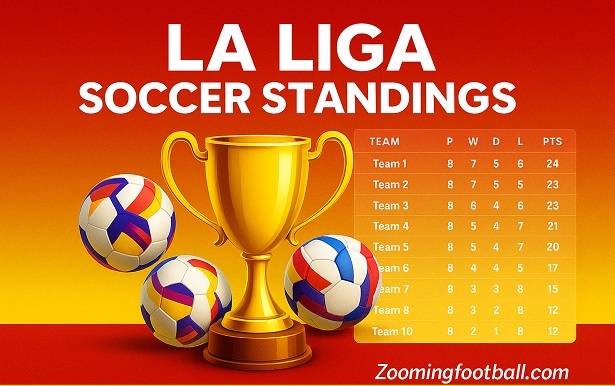La Liga soccer standings show how teams in Spain’s top football league are performing. For American fans, this is like looking at the NFL or NBA standings—but with some unique twists. Knowing the standings helps fans follow who’s winning, losing, or in danger of relegation. As the popularity of European soccer grows in the U.S., more viewers are checking the La Liga table every week.
This blog covers all you need to know about how La Liga standings work, why they matter, and how they compare to other leagues like the Premier League. Whether you’re a Real Madrid supporter or just getting into Spanish soccer, this guide is for you.
What Are La Liga Soccer Standings?

La Liga standings are refreshed after every match, showing each team’s exact position in the league table. These rankings rely on a simple points system: 3 points for a win, 1 point for a draw, and 0 for a loss. As a result, the team with the highest points leads the table. In addition, the table shows goals scored, goals conceded, goal difference, and matches played, which are all crucial in breaking ties. If two teams finish with the same points, La Liga uses head-to-head results, followed by goal difference and total goals scored, to determine the higher rank.
Typically, the La Liga table includes 20 teams, each playing 38 games—home and away against every other team. This format, popular in most European football leagues, ensures balance. At the end of the season, the top-ranked team is crowned league champion, while the bottom three teams are relegated to the Segunda División. Throughout the campaign, each club tries to accumulate points through consistent performances, aiming to avoid relegation or secure a spot in European competitions.
Historical Overview of La Liga Soccer Standings
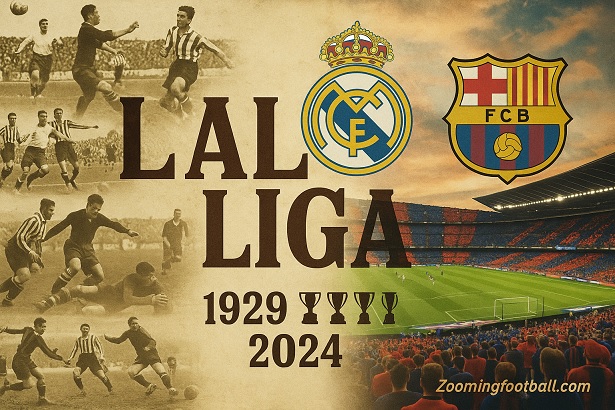
La Liga soccer standings have a rich legacy that began in 1929, marking nearly a century of top-tier football in Spain. From the very start, only a handful of clubs have consistently led the league. Most notably, Real Madrid and FC Barcelona have dominated the La Liga table, often switching positions at the top. Over the years, their trophy-winning consistency and elite squads have ensured they rarely fall below the top spots.
Besides the iconic duo, clubs like Atlético Madrid, Valencia, and Sevilla have experienced memorable runs. However, their success has often come in spurts rather than long-term dominance. In several seasons, the top of the La Liga standings has seen fierce battles, but Barcelona and Madrid tend to reclaim their thrones. This trend, while predictable at times, showcases the high level of competition that pushes all teams to improve.
Dominant Teams in La Liga Soccer Standings History
Real Madrid leads in La Liga titles, having secured more championships than any other club. Additionally, they’ve topped the table for the most seasons. Meanwhile, Barcelona has remained a powerful rival, particularly shining in the past two decades. Their tactical brilliance and star-studded lineups have often kept them neck and neck with Madrid. As time went on, both clubs shaped the narrative of La Liga’s soccer hierarchy.
Most League Titles and Consistent Top Finishers
Here’s a detailed breakdown of the top-performing clubs in La Liga:
| Club | Titles Won | Seasons in Top 4 |
| Real Madrid | 36 | 70+ |
| FC Barcelona | 27 | 70+ |
| Atlético Madrid | 11 | 60+ |
| Valencia | 6 | 40+ |
| Athletic Bilbao | 8 | 30+ |
Relegation and Promotion Patterns: La Liga Soccer Standings
Every season, the La Liga soccer standings decide not only the champion but also which clubs face relegation. The bottom three teams are dropped to the Segunda División, making room for the top two from the lower league and one playoff winner to rise. This ongoing cycle ensures competitiveness and hope for smaller clubs. In turn, it keeps the league vibrant and full of surprises each year.
How La Liga Standings Impact on European Soccer Competitions
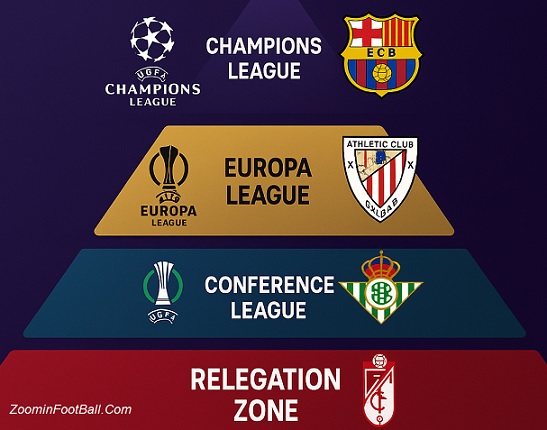
La Liga soccer standings don’t just crown the league champion. In fact, they play a major role in determining which Spanish clubs qualify for elite European tournaments. At the end of each season, teams are not only ranked for domestic honors but also judged for international eligibility. Because of this, league placement can shape a club’s financial future and global presence. Securing a top-four spot, in particular, unlocks the gateway to the world-famous UEFA Champions League.
Meanwhile, clubs that finish fifth and sixth still enjoy European football by entering the Europa League and the Europa Conference League. These competitions, while less glamorous, give mid-table La Liga teams like Real Betis or Villarreal a chance to gain valuable experience, showcase their talent, and boost their revenue through sponsorships and broadcasting deals.
UEFA Champions League Qualification
Every La Liga club dreams of making the Champions League. To do so, they must finish among the top four in the La Liga standings. Not only does this bring global exposure, but it also means big prize money, sponsorship boosts, and attraction for top-tier players. Naturally, this leads to fierce competition, especially in the second half of the season when every point becomes crucial. So, teams often rotate their squads and play tactically just to stay in contention for these prized spots.
Europa League and Conference League Spots
Although the Champions League gets the spotlight, the Europa League and Europa Conference League matter too. Generally, the fifth and sixth-placed La Liga teams qualify for these events. That said, domestic cup winners can also affect which teams qualify. For example, if the Copa del Rey winner already qualifies for the Champions League, their spot moves down the La Liga table, creating unexpected chances for others. This adds more drama for clubs in the mid-tier.
Relegation to Segunda División
While the top clubs chase glory, the bottom three fight to avoid the drop. Ending the season in the bottom three of the La Liga standings means relegation to the Segunda División. This change is massive — clubs lose millions in TV rights, fan attendance drops, and often, star players leave. Even worse, some clubs never fully recover. Therefore, avoiding relegation is just as important as qualifying for Europe. In many seasons, the fight for survival goes down to the very last game, keeping fans on the edge of their seats.
Key Metrics That Define La Liga Rankings
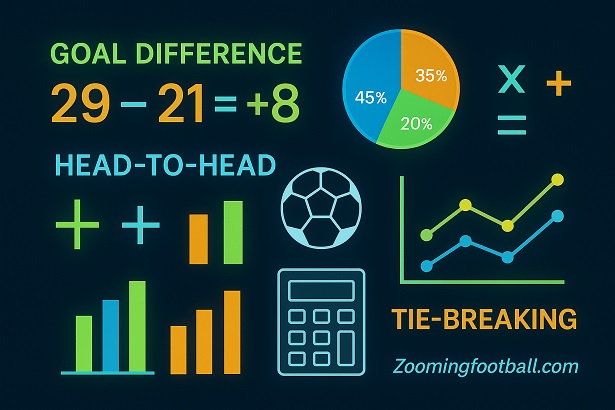
Although points decide the main ranking, other key factors also shape the La Liga soccer standings. In fact, many fans don’t realize how much these extra statistics can influence a team’s position. For example, goal difference, head-to-head records, and even away goals play a crucial role when teams are tied on points. Because of this, understanding these metrics helps fans and analysts look beyond the surface. It also explains why some teams rise or fall despite similar point totals.
Moreover, clubs pay close attention to these numbers throughout the season. They know that a single goal — either scored or conceded — can be the difference between Champions League qualification and missing out. This is why every match matters, even the ones that seem less important on paper.
Goal Difference and Head-to-Head Record
When two teams are level on points, the first thing that decides who ranks higher is their head-to-head record. If one team wins both meetings, they take the higher spot. However, if those games end in a draw or split wins, the next factor is goal difference — the total goals scored minus goals conceded. As a result, teams try not just to win, but to win big and defend well. These rules add pressure, especially in close title races or relegation battles.
Tie-Breaking Rules Explained
Here’s how La Liga tie-breakers work when teams are tied on points:
| Rank | Tie-Breaking Metric |
| 1 | Head-to-head points |
| 2 | Head-to-head goal difference |
| 3 | Overall goal difference |
| 4 | Goals scored |
| 5 | Fair play ranking |
Each of these tie-breakers makes the league more competitive and transparent. So, teams must stay consistent in both attack and defense.
Home vs. Away Performance Stats
Another vital aspect of La Liga rankings is how well teams perform at home versus on the road. Usually, teams play stronger on their home ground because of fan support and familiar conditions. On the other hand, away games are tougher due to travel fatigue and less crowd support. Some clubs like Sevilla or Real Sociedad often dominate at home but struggle away. Consequently, this imbalance can determine whether a club finishes in the top 4, mid-table, or faces relegation threats.
Top La Liga Clubs and Their Historic Standings

When it comes to La Liga soccer standings, a few clubs always seem to rise above the rest. In fact, Real Madrid, FC Barcelona, and Atlético Madrid have set the standard for Spanish football. Not only do they have massive budgets and top players, but they also benefit from smart management, long-term planning, and solid youth development. That’s why, even during tough times, these clubs remain competitive. Time after time, they bounce back stronger.
Besides, their consistency isn’t luck—it’s built on experience, strategy, and a winning culture. As a result, they dominate the top of the league season after season. Below, we’ll explore how each of these teams has built their historic status.
Real Madrid’s Legacy in the League
Real Madrid stands alone with the most La Liga titles in history. Year after year, they’ve proven their dominance both in Spain and across Europe. Throughout their legacy, they’ve fielded legends like Cristiano Ronaldo, Zinedine Zidane, and Raúl. Moreover, their consistent performances place them at the top of the La Liga standings almost every season. With more than 36 titles, they’ve become the most successful club in Spain.
In addition, Real Madrid’s global appeal and tactical adaptability make them a constant threat, no matter the season. Even during rebuilding phases, they remain competitive and chase silverware.
FC Barcelona’s Consistency in Top Ranks
FC Barcelona has long been known for its iconic tiki-taka playing style and its deep-rooted football culture. For more than two decades, they’ve ranked among the top 4 La Liga teams almost every season. What sets them apart is their world-class youth academy, La Masia, which has produced stars like Lionel Messi, Xavi, and Iniesta.
Furthermore, their focus on possession-based play and homegrown talent has helped them stay near the top, even during transitions. Because of this, fans and analysts consider them one of the most consistent clubs in Europe.
Atlético Madrid and Other Strong Contenders
Atlético Madrid, often viewed as the league’s underdog, has built a legacy of its own. Thanks to manager Diego Simeone, the club has transformed into a real title contender. Even with fewer resources, they’ve won La Liga and regularly challenge both Barcelona and Real Madrid. This proves that strong leadership and tactical discipline can close the gap with bigger clubs.
Meanwhile, teams like Sevilla, Real Betis, and Villarreal have also had seasons where they pushed for the top four. However, they’ve yet to match the long-term success of the big three.
Most Competitive La Liga Seasons of All Time

La Liga standings aren’t just about numbers—they tell stories filled with tension, heartbreak, and triumph. Some seasons, in particular, have captured the world’s attention with nail-biting finishes and shocking twists. Whether it’s a title race going to the wire or an underdog upsetting giants, these moments are what make La Liga truly special.
For fans, these seasons offer unforgettable drama. More importantly, they prove how unpredictable and competitive Spanish football can be—even beyond the usual powerhouses.
Closest Title Races in History
Several seasons have featured razor-thin margins at the top. Take the 2006–07 La Liga season, for example. Real Madrid and Barcelona finished tied on points, but Madrid claimed the title through a superior head-to-head record. Even earlier, the 1993–94 season saw FC Barcelona edge out Deportivo La Coruña on goal difference in the final minutes.
These seasons remind us that every goal and every point truly matters. One result can shift the entire league table.
Dramatic Relegation Battles
The bottom of the table has seen just as much action. In 2022, Cádiz CF survived on the last day thanks to a dramatic late goal. Similarly, clubs often need results in the very last round to avoid falling into the Segunda División.
These battles, while less glamorous, are just as emotional. After all, they determine the financial and sporting future of entire clubs.
Breakout Seasons by Underdog Teams
Not every story is about the big names. Smaller clubs like Getafe, Granada, and Real Sociedad have had magical runs—breaking into the top six and even qualifying for European competitions.
These standout seasons prove that with good coaching and team chemistry, even underdogs can shake up the La Liga standings. In many cases, they also add extra fire to the title and relegation races.
How to Read and Interpret La Liga Soccer Standings Like a Pro
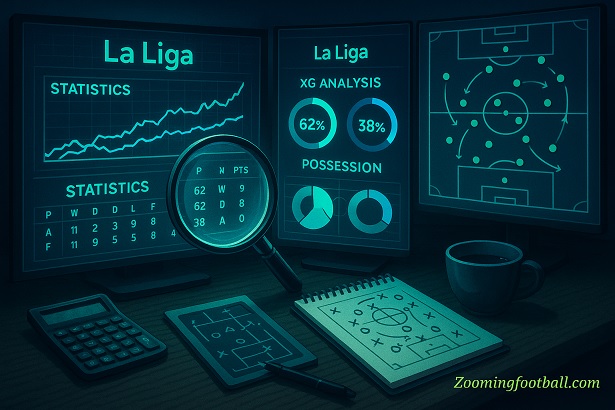
Understanding La Liga standings takes more than checking who’s first or last. Sure, points matter—but if you want to analyze performance like a pro, you need to go deeper. Advanced stats, short-term form, and tactical trends reveal much more than the basic table does.
By using the right tools and focusing on key metrics, you can accurately predict whether a team is on the rise—or about to crash.
Advanced Stats: xG, Possession %, and More: La Liga Soccer Standings
Let’s start with the numbers that most casual fans overlook.
Expected goals (xG) tells you how many goals a team should have scored based on the quality of chances. If a team’s xG is high but actual goals are low, they’re underperforming.
Meanwhile, possession percentage shows how much control a team has during matches. Passing accuracy, shots on target, and big chances created all reveal how dominant or shaky a team is.
These stats don’t just sound technical—they explain why some teams keep climbing the La Liga soccer standings, even if their point tally hasn’t exploded yet.
Trends That Predict Final Standings
The league is long—38 games long. And that means form matters.
By tracking the last 5-game form of a club, you can spot upward or downward trends. For instance, a mid-table team with 4 straight wins might break into the top six. Conversely, an elite club in a slump could lose ground fast.
Watch for red flags like injuries, fatigue, or a tough upcoming fixture list. These indicators can reveal far more than a quick glance at points.
Fan Tips for Analyzing League Performance
Want to level up your analysis? Start following injury reports, managerial changes, and even weather conditions. Yes, rain can affect match tempo and outcomes!
Use reliable apps like FotMob, SofaScore, and the official La Liga site for live insights, match stats, and form guides. These platforms deliver real-time updates that go beyond the traditional league table.
In short, when you interpret the La Liga standings with deeper context, you’ll understand not just where teams stand—but why.
La Liga Soccer Standings vs. Other European Leagues

When comparing La Liga standings to those of the Premier League, Serie A, or Bundesliga, the differences go far beyond points and positions. Each league has its own unique style, and that influences how standings unfold. In La Liga, tactics, control, and structure shape the competition—leading to fewer wild results but more strategic depth.
While English football dazzles with speed and physicality, and Italian clubs shine with tactical defense, La Liga strikes a calculated balance—which often gives Spanish teams an edge in Europe.
Comparison with Premier League and Serie A
The Premier League is a high-octane sprint. It’s fast, aggressive, and unpredictable. Teams go all-out, making it common to see 4-3 thrillers or dramatic comebacks. On the other hand, Serie A emphasizes strict defending and low-scoring chess matches.
La Liga? It blends both worlds. Teams emphasize possession, passing patterns, and tactical discipline. As a result, the La Liga soccer standings often reflect tight battles, narrow margins, and strategic victories.
This is also why clubs like Real Madrid and Barcelona consistently succeed in European competitions—they’re built to adapt.
How La Liga’s Soccer Style Affects Standings
The slower pace and emphasis on tactical control affect every part of the table. You won’t see as many blowouts as in England, but you will see underdog clubs holding giants to 0–0 or 1–1 draws.
Defensive organization plays a major role. In fact, teams with a rock-solid backline—like Getafe or Osasuna—can finish comfortably mid-table, even without flashy attackers.
Moreover, the format rewards patience. Clubs that focus on ball retention and smart positioning often climb the standings slowly but steadily.
Differences in Competitive Balance
In the past, La Liga faced criticism for being too top-heavy. Real Madrid and Barcelona seemed untouchable. But things have changed.
Clubs like Villarreal, Real Sociedad, and Athletic Club are proving they can compete. Even newly promoted teams have pulled off stunning upsets.
This growing competitive balance has made La Liga one of Europe’s most unpredictable and thrilling leagues. It’s no longer just about the big two.
La Liga Soccer Standings: What They Reveal About Spanish Soccer
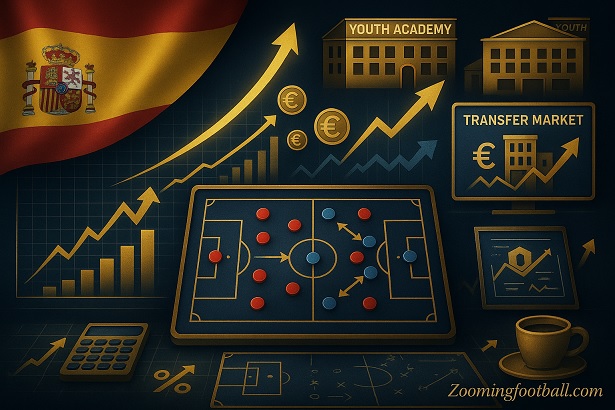
The La Liga standings are more than just a scoreboard. They offer a deeper insight into how Spanish clubs operate—from youth development and financial health to long-term planning and recruitment strategies. A top-four finish signals strength and prestige, but even a mid-table ranking can mark significant progress for smaller clubs.
In fact, for a team with limited resources, finishing 10th in La Liga isn’t just survival—it’s a foundation for future growth and a springboard for attracting new talent, fans, and investors.
Club Strategies Based on Rankings
League position shapes how clubs behave throughout the season. For example, a team hovering just above the relegation zone might spend heavily in the January transfer window to stay afloat. Meanwhile, title contenders or clubs chasing European spots may rotate squads to stay fresh for Champions League or Europa League fixtures.
Simply put, standings influence tactical choices, transfer strategies, and even lineup decisions.
Financial Impact of League Position
There’s no denying it—money follows rankings. Clubs that finish higher on the table earn more from TV rights, sponsorships, ticket sales, and performance-based bonuses. This financial boost helps clubs invest in better players, staff, and infrastructure.
Even climbing from 12th to 9th place can mean a significant revenue increase—enough to sign a key player or expand a youth facility.
Youth Development and League Success
Some clubs rely on homegrown talent to stay competitive without overspending. Teams like FC Barcelona, Athletic Bilbao, and Real Sociedad are well-known for their world-class academies.
Their approach not only builds strong, sustainable squads—but also earns them consistent standings success without relying solely on the transfer market.
Reliable Sources to Track La Liga Soccer Standings

If you want to stay ahead in tracking La Liga standings, knowing where to look is key. Luckily, there are several trusted platforms that deliver real-time updates, match stats, and in-depth analysis. Whether you’re a casual fan or a stats nerd, these tools keep you informed and engaged.
Using reliable sources ensures you’re not misled by outdated or inaccurate standings—especially during tight title races or relegation battles.
Official La Liga Soccer Standings Website and Apps
The official La Liga website — www.laliga.com — is the most accurate and up-to-date source. It updates standings in real-time, offers team stats, and provides detailed match recaps. For fans in the U.S., this site also includes English-language coverage and exclusive video highlights.
For on-the-go updates, the La Liga app is a must-have. It delivers push notifications for goals, red cards, and live standings changes—all in a user-friendly design.
Best Soccer Analytics and Live Score Platforms
Apps like FotMob, OneFootball, and SofaScore do more than just show scores. They provide player ratings, xG stats, heatmaps, and team comparisons. These platforms are excellent for fans who want to understand the “why” behind a team’s rise or fall in the table.
Additionally, analytics sites like WhoScored, FBref, and FlashScore cater to advanced users. These platforms break down every stat—from possession percentages to expected goals (xG)—so you can read the standings like a true analyst.
How to Avoid Fake or Outdated Tables
With so much content online, not all of it is trustworthy. Always cross-check the source and date before relying on a league table. Avoid unofficial blogs, random tweets, or fan pages unless they cite official data.
For the most accurate picture, stick to official league outlets or well-established sports platforms.
Interesting, unbelievable, and amazing fun facts about La Liga Soccer Standings

Think you know everything about La Liga standings? Think again. From goats on the pitch to lightning-fast hat-tricks, La Liga’s history is packed with jaw-dropping facts that even seasoned fans find hard to believe. These quirky moments and record-breaking stats make Spanish soccer not just competitive—but unforgettable.
🏆 La Liga’s Biggest Win? A 12-1 Blowout!
Yes, you read that right. Back in 1931, Athletic Bilbao stunned the world by demolishing FC Barcelona with a historic 12-1 scoreline. It’s the largest win in La Liga standings history and still stands as one of soccer’s most shocking results.
🐐 Lionel Messi: The Unbreakable Goal Machine
With a jaw-dropping 474 goals, Lionel Messi remains La Liga’s all-time top scorer. No other player has even come close, making this record almost untouchable in modern football. It’s a stat that defines an era.
🛡️ Only 3 Clubs Have Never Been Relegated
Since the league’s birth in 1929, only Real Madrid, Barcelona, and Athletic Club Bilbao have never dropped out of La Liga’s top flight. Their consistency in the standings over nearly 100 years is simply legendary.
⚡ Fastest Hat-Trick? Just 3 Minutes and 51 Seconds!
In 2015, Kevin Gameiro made history with the fastest hat-trick in La Liga—scoring three goals for Sevilla in under four minutes. Blink, and you’d have missed it!
🧨 Two El Clásicos in Just 96 Hours?!
In 2011, fans got what they jokingly called “El Clásico Overload.” Barcelona and Real Madrid clashed four times in 18 days—including two La Liga matches, a Copa del Rey Final, and a Champions League semi-final. It was chaos, magic, and rivalry at its peak.
🚀 Zaragoza’s Wild Ride from Bottom to Europe
In the 1990s, Real Zaragoza pulled off one of the wildest standings climbs ever—going from near relegation to a Champions League spot in a single season. Talk about a comeback story!
🔒 Longest Unbeaten Run? Real Sociedad Did It First
Before “invincibles” were a trend, Real Sociedad set the bar. Between 1979–1980, they went 38 matches unbeaten, marking one of the most dominant runs in La Liga soccer standings history.
🐐 Yes, a Real Goat Stopped a Match
It’s not a metaphor. In the 1960s, an actual goat ran onto the field during a live match. Play stopped while security wrangled the four-legged fan. To this day, it’s one of the league’s most bizarre and hilarious moments.
👶 Youngest Player Ever? Just 15 Years Old
In 2023, Lamine Yamal became the youngest player in La Liga history when he debuted for Barcelona at just 15. His appearance added a fresh new layer to the evolving standings narrative. You may also like this: Soccer FA Cup
FAQs: La Liga Soccer Standings
How are La Liga points calculated?
Each team earns 3 points for a win, 1 point for a draw, and 0 for a loss. Standings are based on total points throughout the season.
Which team has the most La Liga titles?
Real Madrid holds the record with 35 La Liga championships, followed by Barcelona with 27 titles. These two dominate the historical standings.
How can I check the current La Liga standings?
You can visit official sources like LaLiga.com, or trusted sports sites like ESPN or BBC Sport, where live La Liga tables are updated after every match.
When does the La Liga season usually start and end?
The La Liga season usually begins in August and ends in May, with each team playing 38 matches in total.
Why do La Liga standings matter?
They decide the league champion, who qualifies for the Champions League, and which teams face relegation to lower divisions.
How is goal difference used in La Liga standings?
If teams are tied on points, goal difference (goals scored minus goals conceded) is used to determine who ranks higher in the La Liga standings.
Which teams qualify for Champions League from La Liga?
The top four teams in the La Liga standings qualify for the UEFA Champions League, Europe’s top club competition.
Where can I find historical La Liga standings?
You can check La Liga archives, club websites, or sports databases like Transfermarkt or Soccerway for year-by-year standings.
Conclusion: La Liga Soccer Standings
La Liga soccer standings are more than just a list. They tell the story of a season. For U.S. fans, understanding the table means enjoying the league more. Now that you know how it works, start following your favorite team and dive into Spanish football with confidence!

Oliver Brown, a seasoned football blogger with a knack for insightful commentary, brings decades of passion and expertise to Zooming Football. Known for his sharp analysis and engaging storytelling, Oliver delves deep into the game’s nuances, offering readers a unique perspective on football’s most captivating stories and strategies.

